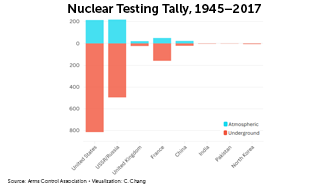Search Results
The toll of a black hole
Scientists measured the gravitational waves produced by two colliding black holes. Learn how familiar analogies, such as the toll of a bell, can help comprehend events at the intergalactic scale. Answer questions about the importance of signal-to-noise ratios in science. Then delve deeper by explaining how changing the individual values of a ratio affects the overall ratio.
Lightning lab
Lightning is a familiar natural phenomenon, but what causes it? In this activity, students will do a short electrostatics lab with sticky tape. They will also compare what happens in regular lightning with what happens in a megaflash.

Nuclear testing tally
Beginning with the first test explosion in 1945, more than 2,000 atomic blasts have rattled the globe. Nuclear testing dwindled after a treaty in the 1990s. Recently, some in the United States have called for resumed testing, which could have serious consequences for the environment and global politics.
Hula-hooping robots
Scientists built hula-hooping robots to answer an old mystery: How does a Hula Hoop stay up? Learn how best to launch and maintain a circulating hoop — and then explore how specific shapes can turn gyrations into a gravity-defying force. You can apply those concepts to then predict the hula-hooping success of other shapes.
All about Analyze This: An article type from Science News Explores
Use this lesson plan to learn about an article type called Analyze This that is published by Science News Explores in print and online. You can also access a lesson plan template that can be used with any Analyze This article. Each Analyze This article includes a graph or data visualization that is paired with questions for students to answer and a short story that provides context.
Literacy Practice: KWL Strategy
Use this lesson plan and the provided template to have your students practice the KWL strategy. This note-taking strategy helps students organize their thoughts and reflect on their knowledge around a particular reading.
Observations vs. Experiments: Two types of research design
In this lesson, students will compare and contrast observational studies with experimental studies and practice identifying the study types from provided examples. Then, they will apply that knowledge to two studies outlined in Science News articles. As an optional assignment, students will be asked to create an example of a possible study.
An eyelash of elegant design
Raindrops might fall on your head, but thanks to your eyelashes, they rarely drip into your eyes. Learn how the simple, elegant design of our eyelashes flicks away water. Answer questions about diverse functions of body hair, all while discussing the value of analogies as a literary device used to improve understanding of unfamiliar concepts.
All about STEM Comics, called Wild Things: An article type from Science News Explores
How can comic strips help teach experimental design of research studies? Use this lesson plan to learn about an article type called Wild Things that is published by Science News Explores in print and online. Wild Things use comic strips that tell the stories of research studies on animals’ biology and behavior. You can also access a lesson plan template that can be used with any Wild Things article.
Literacy Practice: 3-2-1 Strategy
Use this lesson plan and the provided template to have your students practice the 3-2-1 strategy. This literacy strategy is a quick way to check students’ understanding of a concept, reading or lesson. It helps them summarize and organize their thoughts by listing three responses to one prompt, two responses to another prompt and one response to a final prompt.
All about Technically Fiction: An article type from Science News Explores
Use this lesson plan to learn about an article type called Technically Fiction that is published by Science News Explores in print and online. Technically Fiction articles focus on a fictional phenomenon and explain whether it could be possible and the science it would take to make it a reality. You can also access a lesson plan template that can be used with any Technically Fiction article.
Literacy Practice: Concept Map
Use this lesson plan and the provided template to have your students practice creating concept maps for any article. This literacy strategy boosts critical thinking and reading retention by having students organize information and connect important ideas, concepts and terms.